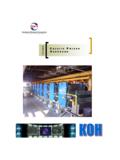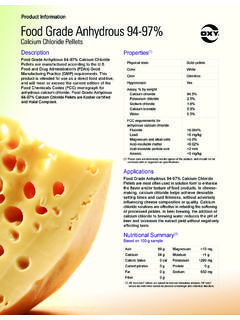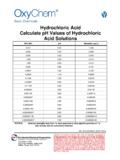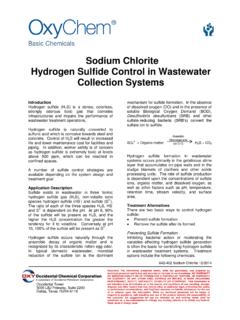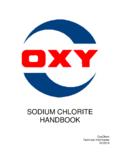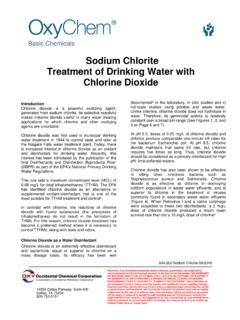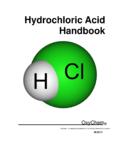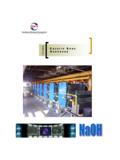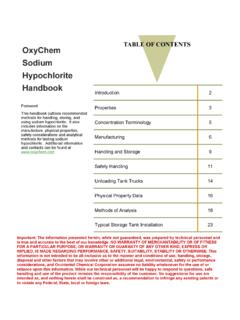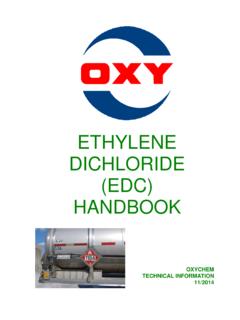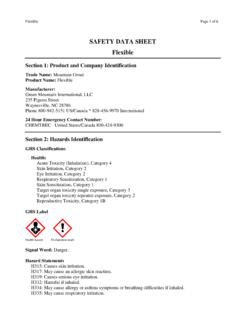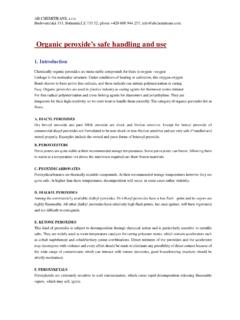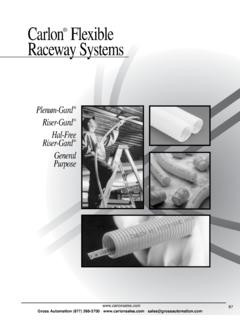Transcription of Calcium Chloride - Occidental Petroleum
1 Calcium ChlorideA Guide to handling and StorageTable of ContentsAbout This Guide ..1 Safe handling and storage Packaged Products ..2 Package Types ..2 Packaged Product handling ..2 Packaged Product storage .. 2 Bulk Solid Shipment Modes ..3 Bulk Solid handling ..3 Bulk Solid storage ..3 Bulk Liquid Shipment Modes ..3 Bulk Liquid handling ..3 Bulk Liquid storage ..5 Releasing the Empty Tank Truck or Tank Car for Return Transit ..5 Summary .. 5 About This GuideThis guide presents general information pertaining to the handling and storage of Calcium Chloride products from Occidental Chemical Corporation (OxyChem). It is intended to complement other OxyChem litera-ture on Calcium Chloride products. It is not intended to serve as a complete and comprehensive technical ref-erence for the topics presented.
2 It is the responsibility of the end user to determine the most appropriate way to apply this information to their specific situation. OxyChem publishes and regularly updates Material Safety Data Sheets (MSDS) for each Calcium Chloride product it produces. These documents provide information on health and handling precautions, safety guidelines and product status relative to various government regulations. Obtain Material Safety Data Sheets and other product and application information at 12 Safe handling and StorageTo successfully handle and store liquid and dry Calcium Chloride , it is important to understand that five product attributes strongly influence most of the recommended practices.
3 1. Calcium Chloride is hygroscopic. It is capable of absorbing moisture from the air. This can cause clumping and caking in dry Calcium Chloride products, such as pellets, flakes and Calcium Chloride is deliquescent. Solid products are capable of absorbing enough moisture from the air to become Calcium Chloride has an exothermic heat of solution. Solid products release a large amount of heat when dissolved in Chlorides in the presence of water and oxygen are associated with the accelerated corrosion of common metals, such as steel, copper and Calcium Chloride brines are electrically conductive. There is a risk of electric shock if energized electrical equipment is handled with hands or fabric gloves that are wet with must be familiar with the contents of the MSDS and abide by the guidelines contained therein.
4 End users are responsible for maintaining full compliance with federal, state, provincial and local requirements applicable to handling and storing Calcium ProductsPackage types. Solid Calcium Chloride products come in a variety of package types, including bags, boxes, pails, drums and Flexible Intermediate Bulk Contain-ers (FIBCs).1. Bags are made of plastic or multilayered paper containing a moisture barrier. The bag closure is either a valve-type* or heat-seal. 2. Boxes are constructed of cardboard with a plastic liner that is sealed with a twist tie. 3. Pails are heavy-duty plastic with snap-on lids. 4. Drums are standard 50-gallon steel with a removable top held in place with a clamping FIBCs have a woven polymer exterior, a plastic liner and a bottom spout for unloading.
5 Packaged products are delivered on wooden pallets, and most are either covered with a plastic shroud or stretch-wrapped. Available package type, size and pallet configuration will vary by product. Packaged product handling . Packaged products are shipped via flatbed truck, enclosed van, intermodal container or boxcar. Pallets loaded onto a flatbed truck should be fully covered by tarps to maintain the cleanli-ness and integrity of the packaging and to keep the load secure while in transit. A full pallet of product requires a forklift or pallet jack to lift and move. Pallets are typically four-way, meaning that they may be lifted from all four sides. The exceptions to this are those carrying FIBCs or drums, which are two-way only.
6 Product inventory should be managed on a first-in, first-out basis to minimize the chance of quality issues arising from moisture absorption that occurs over time. If a bag becomes damaged, it should be mended and used ahead of others. Packaged product storage . Palletized product covered by an intact plastic shroud may be stored outdoors on a well-drained, asphalt or concrete sur-face. If the shroud is torn, pierced or removed, the palletized product should be stored indoors or under a waterproof tarp. Products packaged in boxes, drums or FIBCs are typically not shrouded. Therefore, these packages should be stored indoors or under a water-proof tarp. Palletized pails are stretch-wrapped, but not shrouded.
7 Because pails are watertight, they may be stored outdoors without a waterproof covering. Full pallets of bags can typically be stacked three high in a 2-2-1 configuration, with the top row straddling the center line of the first two rows. Pallets of pails, boxes or drums may be stacked three high and two wide (2-2-2). Pallets of FIBCs are typically stacked two high and two wide (2-2). *An internal plastic flap that is pressed against the top panel by the product in the packages should be stored indoors in a dry area. Unused bags with a valve-type closure should lie flat so that product presses the valve against the top panel of the bag to maintain a seal. Any package that has been opened, but only partially used, must be tightly resealed to prevent exposure to humid air that may lead to caking and liquid brine formation.
8 Bulk Solid Shipment ModesBulk shipments are made in hopper cars of approximately 90 tons and in hopper trucks of various capacities. Bulk solid handling . Bulk solid Calcium Chloride may be unloaded and transported by a number of different methods, including drag chains, screw conveyors, pneumatic conveyors, bucket elevators and belt con-veyors. The most effective handling equipment is mechanically reliable while minimizing potential detrimental impacts from attrition, exposure to humid air and dust emissions. Hot-dipped, galvanized and stainless steels are materials that have been shown to work well for solids- handling equipment operating at ambient tem-peratures.
9 After formation of a rust-colored surface layer, these materials are resistant to general-ized corrosion. Stainless steels may not be suitable for handling hot, bulk solids (>100 F [>38 C]), since they are susceptible to Chloride stress cracking at ele-vated solid storage . To prevent caking and clumping problems in storage , the hopper design should mini-mize product exposure to humid air. If uniform par-ticle-size distribution is important, the design should take into consideration the effects of hopper configu-ration on particle-size segregation, because sifting occurs when filling a bin. The fine particles sift through the coarse particles, allowing the fines to concentrate in the center, while the coarse particles roll or slide to the outside.
10 In a poorly designed hopper, solids will empty from the center of the pile while solids on the sides remain stagnant. In a well-designed mass flow hopper, all solids move downward together as the hopper is emptied, helping to maintain a more uniform particle-size distribution. The preferred material of construction for large hoppers is carbon steel with an internal epoxy-based lining and an exterior epoxy-based paint. Stainless steels that are resistant to stress cracking are effective for smaller, surge hoppers, such as those that provide surge capacity for packaging systems. A rust-colored surface layer forms on the stainless steel; however, generalized corrosion under ambient conditions is low.
